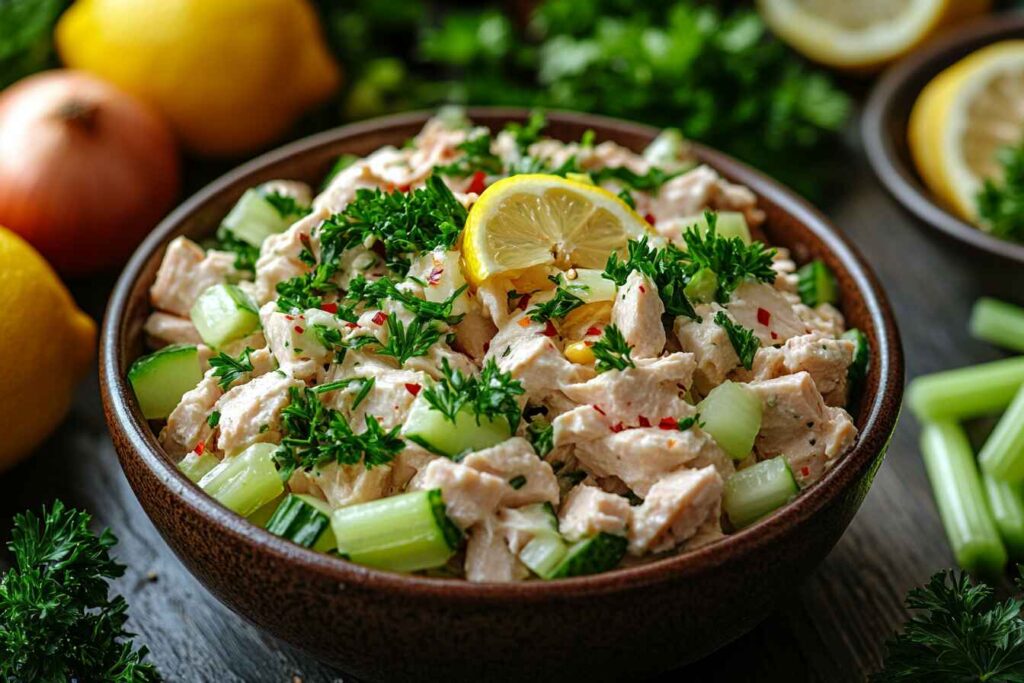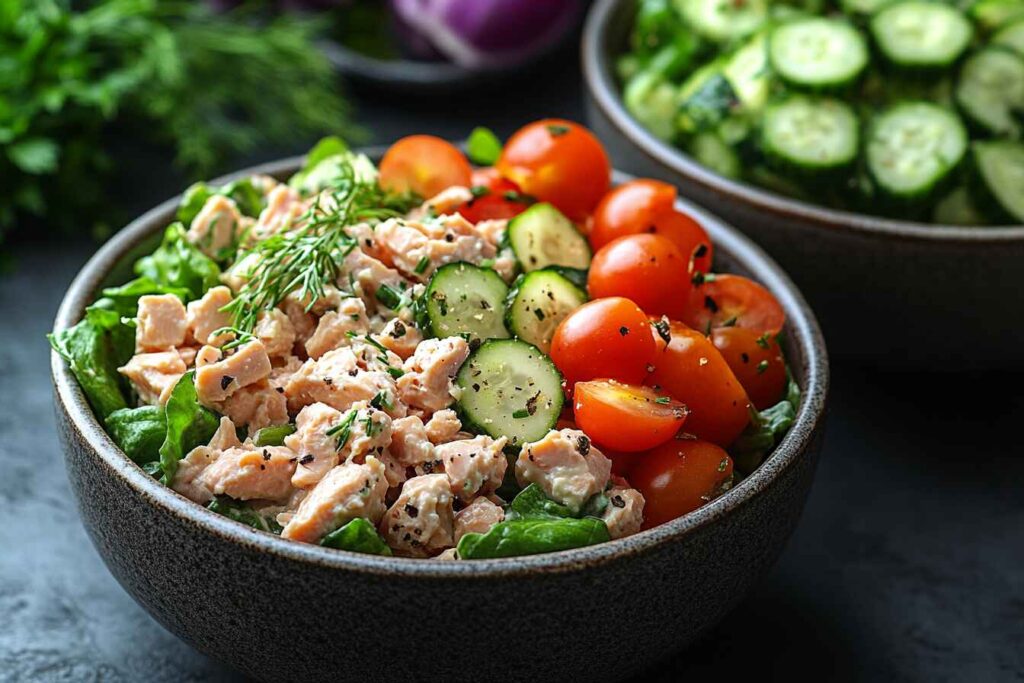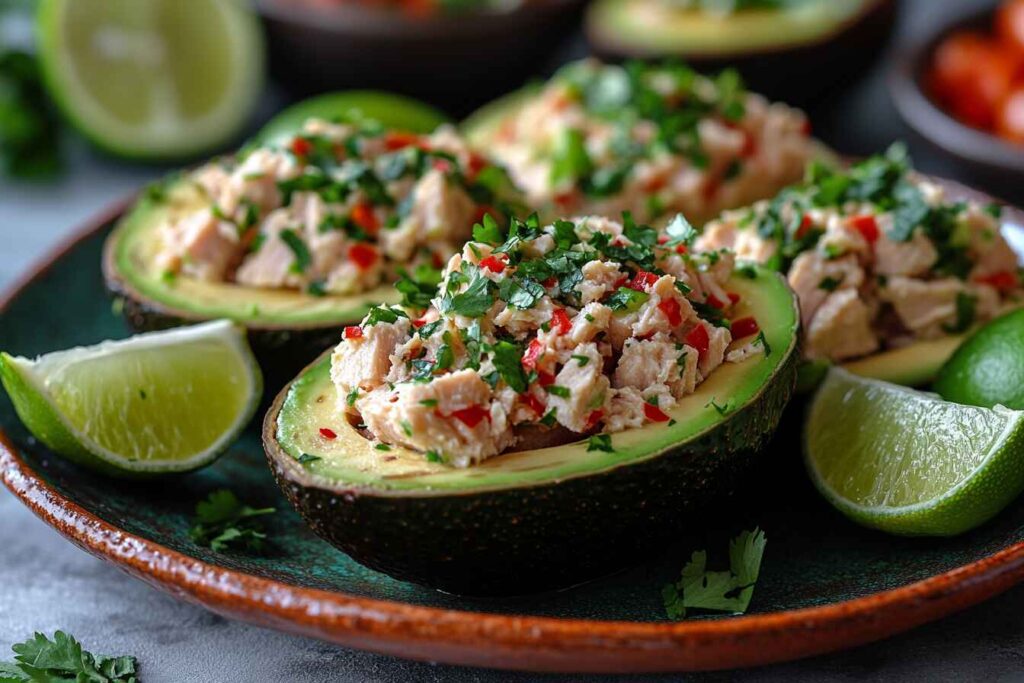If you’ve ever whipped up a quick tuna salad for lunch or dinner, you might’ve wondered: “How healthy is this?” It’s a valid question! Homemade tuna salad is one of those dishes that feels light and satisfying, but its nutritional value depends on what you toss into the mix. Let’s dive deep into this crowd-pleaser and uncover what makes it such a beloved choice—and what to watch out for!
Table of Contents
Introduction to Homemade Tuna Salad
Why Is Tuna Salad a Popular Dish?
Tuna salad is like that friend who’s always there when you need them. It’s quick to make, requires minimal effort, and is incredibly versatile. Whether you’re spreading it on bread, scooping it with crackers, or eating it straight out of a bowl, it’s hard to go wrong with tuna salad. Plus, the combination of creamy textures and savory flavors makes it irresistibly comforting.
Overview of Nutritional Benefits in Tuna
Let’s start with the star of the show: tuna! Tuna is a lean, protein-packed fish loaded with omega-3 fatty acids, which are essential for brain and heart health. It’s also rich in vitamins like B12 and minerals like selenium, both of which support your immune system and overall well-being. Sounds like a winner, right? But keep reading—there’s more to the story.
Did You Know? A 3-ounce serving of canned tuna (in water) contains about 100 calories, 22 grams of protein, and almost no carbs!

Breaking Down the Key Ingredients in Tuna Salad
Nutritional Profile of Tuna (Canned vs. Fresh)
The type of tuna you use makes a big difference. Fresh tuna is lower in sodium but harder to prepare, while canned tuna is convenient and shelf-stable. However, canned tuna often comes packed with extra sodium, especially if it’s stored in brine. If you’re watching your salt intake, opt for tuna packed in water instead of oil or brine.
| Type of Tuna | Calories (per 3 oz) | Protein | Sodium |
|---|---|---|---|
| Fresh Tuna | 120 | 25g | 50mg |
| Canned Tuna (in water) | 100 | 22g | 250mg |
| Canned Tuna (in oil) | 150 | 20g | 300mg |
The Role of Mayonnaise and Its Alternatives
Ah, mayonnaise—the creamy glue that holds everything together. While mayo gives tuna salad its rich, indulgent texture, it’s also a major calorie bomb. A single tablespoon of mayonnaise can add 90 calories and 10 grams of fat to your dish. If you’re trying to keep things light, consider swapping it out for healthier alternatives like Greek yogurt or mashed avocado.
Pro Tip: For a tangy twist, mix your tuna with Dijon mustard or a splash of lemon juice instead of mayo.
Add-ins: Vegetables, Herbs, and Spices
What’s tuna salad without a little flair? Common add-ins like celery, onions, and pickles not only enhance the flavor but also add a nutritional boost. Celery and onions provide fiber, while pickles add a delightful crunch without piling on the calories. Want to take it up a notch? Toss in some fresh dill, parsley, or a pinch of smoked paprika.
Bread or Crackers: Impact on Nutritional Value
Are you team sandwich or team cracker? Either way, what you pair your tuna salad with can significantly impact its nutritional profile. Whole-grain bread or crackers are better choices than their white-flour counterparts, as they offer more fiber and nutrients. If you’re watching carbs, ditch the bread altogether and serve your tuna salad in a lettuce wrap or over a bed of greens.
Health Benefits of Homemade Tuna Salad
High Protein Content for Muscle Growth
One of the biggest perks of tuna salad is its protein punch. Protein is essential for building and repairing muscles, making it an excellent choice for athletes, gym-goers, or anyone looking to stay energized throughout the day. Just one serving of tuna salad can provide over 20 grams of protein, which is about 40% of your daily needs.
Omega-3 Fatty Acids for Heart Health
Tuna is rich in omega-3 fatty acids, the good fats that help reduce inflammation, lower blood pressure, and keep your heart ticking smoothly. Regularly eating omega-3-rich foods like tuna can even lower your risk of heart disease. So, go ahead and give yourself a pat on the back for choosing tuna salad—it’s a heart-healthy move!
Essential Vitamins and Minerals
Did you know that tuna salad is a mini multivitamin in disguise? It’s loaded with vitamin B12, which supports brain function, and selenium, a powerful antioxidant that helps protect your cells from damage. If you add colorful veggies like carrots or peppers, you’ll also get a dose of vitamins A and C for good measure.
Quick Fact: Just one cup of tuna salad with veggies can provide nearly 50% of your daily selenium needs!
Common Nutritional Challenges of Tuna Salad
High-Calorie Count from Mayonnaise
We all love the creamy texture mayo brings to tuna salad, but it comes at a cost: calories and fat. If you’re not careful, a couple of scoops of mayo can turn your healthy lunch into a calorie overload. For people trying to lose weight or eat clean, this can be a major setback.
Fun Fact: Just 2 tablespoons of mayo add about 180 calories and 20 grams of fat!
Sodium Levels in Canned Tuna
Here’s a sneaky culprit you might not think about: sodium. Many canned tuna brands pack their product in salty brine, which can quickly push your sodium intake over the daily recommended limit. High sodium levels can lead to bloating, high blood pressure, and even heart issues over time.
Mercury Concerns in Tuna Consumption
You’ve probably heard about mercury in fish, and tuna isn’t exempt. While the occasional tuna salad won’t hurt, eating too much tuna—especially albacore—can expose you to mercury, which isn’t great for your nervous system. This is particularly important for pregnant women and young children.
Did You Know? The FDA recommends limiting albacore tuna to 6 ounces per week for adults.
Solutions to Common Nutritional Problems
Low-Calorie Substitutes for Mayonnaise
Ready to cut the calories without losing the creaminess? Try these easy swaps:
- Greek Yogurt: High in protein and low in fat, it’s a fantastic alternative.
- Avocado: Mash it up for a creamy, nutrient-rich base.
- Hummus: Adds a unique flavor while keeping things light.
Pro Tip: Mix half mayo and half Greek yogurt for a gradual transition to healthier options.
Choosing Low-Sodium or Fresh Tuna
If sodium is a concern, look for tuna labeled “low sodium” or “no salt added.” Better yet, prepare fresh tuna at home by searing or poaching it. Fresh tuna not only tastes incredible but also gives you full control over the seasoning.
Safe Tuna Consumption Guidelines
Don’t let mercury fears scare you off! Stick to light tuna instead of albacore, as it contains less mercury. Balance your seafood consumption by incorporating other low-mercury fish like salmon or shrimp. Variety is the spice of life—and the key to a well-rounded diet.
How to Customize Tuna Salad for Specific Diets
Keto-Friendly Tuna Salad Options
On a keto diet? Tuna salad can be your best friend! Stick to high-fat, low-carb ingredients like avocado, full-fat Greek yogurt, and olive oil. Skip the crackers and serve your tuna salad in lettuce wraps or stuffed into bell peppers for a satisfying meal that’s totally keto-approved.
Keto Hack: Add a hard-boiled egg to boost the fat and protein content while keeping it keto-friendly.
Low-Fat Tuna Salad for Weight Loss
If you’re aiming to shed some pounds, go for a low-fat version of tuna salad. Replace mayo with non-fat Greek yogurt and load up on fiber-rich veggies like cucumbers, celery, and cherry tomatoes. Not only will this reduce the calorie count, but it’ll also keep you full for longer.
Gluten-Free Tuna Salad Variations
For those avoiding gluten, tuna salad is a safe bet—just be mindful of what you pair it with. Instead of traditional bread or crackers, try serving your salad over quinoa, mixed greens, or baked sweet potato rounds. These options are naturally gluten-free and add an interesting twist to your meal.
Quick Tips for Maximizing Nutritional Value
Choosing the Right Tuna: Fresh vs. Canned
Fresh tuna wins hands down when it comes to taste and lower sodium, but canned tuna is unbeatable for convenience. To get the best of both worlds, choose high-quality canned tuna in water, not oil, and always drain it well before using.
Adding Superfoods for an Extra Boost
Why stop at basic tuna salad when you can turn it into a nutritional powerhouse? Toss in ingredients like chia seeds, flaxseeds, or even spirulina powder. These superfoods pack a punch of nutrients and add a unique texture to your dish.
Pairing Tuna Salad with Healthy Side Dishes
Complete your meal by pairing your tuna salad with healthy sides. A fresh fruit salad, a bowl of roasted veggies, or even a small serving of whole-grain pasta can round out your plate while keeping things nutritious and balanced.
Fun Pairing: Tuna salad and roasted sweet potato wedges make an unbeatable duo!
Comparing Homemade and Store-Bought Tuna Salad
Nutritional Differences to Consider
Let’s face it, store-bought tuna salad can be a tempting grab-and-go option, but is it worth it? Most pre-made versions are loaded with hidden calories, sodium, and preservatives. They often use excessive mayonnaise or low-quality oils to extend shelf life, which compromises both taste and nutrition.

Did You Know? A typical store-bought tuna salad serving can contain up to 500 calories, compared to 200-300 calories for a homemade version!
Cost-Effectiveness of Homemade Versions
Making your own tuna salad isn’t just healthier—it’s also cheaper! A can of tuna, a few veggies, and some basic pantry staples can yield multiple servings for a fraction of the cost of store-bought salads. Plus, you have full control over portion sizes and ingredient quality.
Controlling Ingredients and Portion Sizes
One of the biggest perks of homemade tuna salad is customization. You decide how creamy, spicy, or tangy it is. Want more veggies? Toss them in. Prefer less mayo? Easy fix. By preparing it at home, you can cater to your dietary needs and flavor preferences without compromise.
Recipe Ideas for Nutritional Tuna Salads
Classic Tuna Salad Recipe with a Healthy Twist
This version keeps the flavor you love while making a few healthy tweaks. Here’s what you’ll need:
| Ingredient | Quantity |
|---|---|
| Canned tuna (in water, drained) | 1 can (5 oz) |
| Greek yogurt | 2 tablespoons |
| Diced celery | 1/4 cup |
| Diced red onion | 2 tablespoons |
| Lemon juice | 1 teaspoon |
| Dill (fresh or dried) | 1 teaspoon |
| Salt and pepper | To taste |
Instructions:
- In a medium bowl, mix the tuna and Greek yogurt until well combined.
- Add the celery, onion, lemon juice, and dill, then stir to incorporate.
- Season with salt and pepper to taste.
- Serve chilled on whole-grain bread, in a lettuce wrap, or over mixed greens.
Pro Tip: Double the recipe and store leftovers in the fridge for up to 3 days.
Mediterranean-Style Tuna Salad Recipe
Take your taste buds on a trip to the Mediterranean with this vibrant variation.
| Ingredient | Quantity |
|---|---|
| Canned tuna (in olive oil, drained) | 1 can (5 oz) |
| Cherry tomatoes (halved) | 1/2 cup |
| Chopped cucumbers | 1/4 cup |
| Kalamata olives (sliced) | 2 tablespoons |
| Feta cheese (crumbled) | 2 tablespoons |
| Olive oil | 1 tablespoon |
| Lemon juice | 1 teaspoon |
| Oregano | 1/2 teaspoon |
| Salt and pepper | To taste |
Instructions:
- Combine tuna, cherry tomatoes, cucumbers, olives, and feta in a bowl.
- Drizzle with olive oil and lemon juice.
- Sprinkle with oregano, salt, and pepper, then toss gently.
- Enjoy as is, or serve with pita bread for a Mediterranean feast.
Avocado-Based Creamy Tuna Salad Recipe
This mayo-free version is perfect for avocado lovers:
| Ingredient | Quantity |
|---|---|
| Canned tuna (in water, drained) | 1 can (5 oz) |
| Mashed avocado | 1 medium avocado |
| Chopped cilantro | 1 tablespoon |
| Chopped jalapeño (optional) | 1 teaspoon |
| Lime juice | 1 teaspoon |
| Salt and pepper | To taste |
Instructions:
- In a bowl, mix tuna and mashed avocado until smooth.
- Add cilantro, jalapeño (if using), and lime juice.
- Season with salt and pepper.
- Serve with veggie sticks or in a lettuce wrap for a light, refreshing meal.

Conclusion: Why Homemade Tuna Salad Is a Healthy Choice
Recap of Nutritional Benefits
Homemade tuna salad is a nutrient-packed dish that’s as versatile as it is delicious. From protein and omega-3s to essential vitamins and minerals, it offers a wealth of benefits in every bite. Plus, with endless customization options, it’s easy to tailor to your dietary needs and taste preferences.
Encouragement to Experiment with Ingredients
Step out of the (tuna) can and get creative! From experimenting with fresh add-ins to swapping mayo for Greek yogurt, the options are limitless. Homemade tuna salad isn’t just a dish—it’s an opportunity to unleash your culinary imagination. Grab that can of tuna and start mixing. Your taste buds—and your health—will love you for it!
Final Tip: Always keep a can of tuna in your pantry. It’s your secret weapon for quick, healthy meals anytime!

